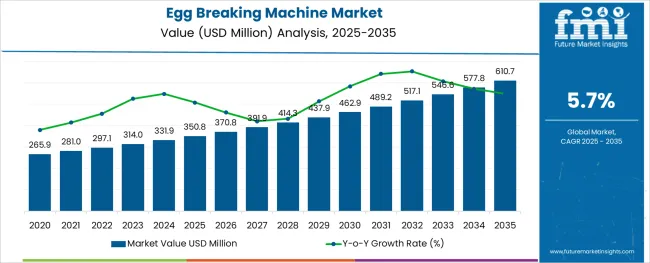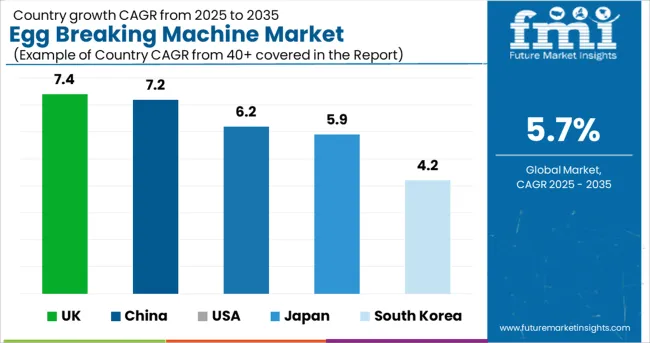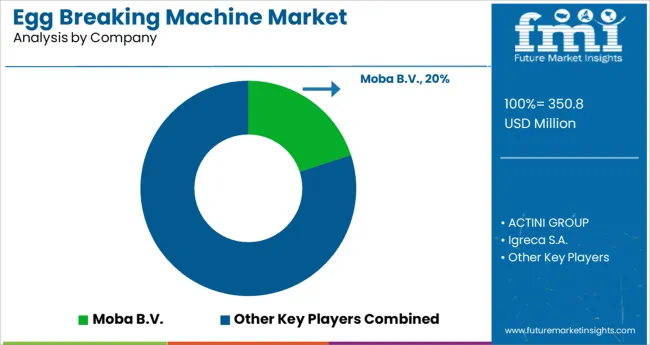The Egg Breaking Machine Market is estimated to be valued at USD 350.8 million in 2025 and is projected to reach USD 610.7 million by 2035, registering a compound annual growth rate (CAGR) of 5.7% over the forecast period.

The alginic acid market is undergoing consistent growth, propelled by rising demand from food processing, pharmaceutical formulations, and cosmetic applications. A growing focus on natural and sustainable ingredients in manufacturing processes has positioned alginic acid as a preferred biopolymer across industries.
The market is further supported by its diverse functional benefits, including water retention, gelling, and stabilizing properties, which make it indispensable in high-performance formulations. Increased regulatory acceptance of alginates as safe additives and the push towards cleaner labeling in food and personal care products have reinforced their adoption.
Ongoing innovation in extraction technologies and the utilization of algae as a renewable resource are paving the way for cost-effective production and expanded applications, ensuring sustained market expansion in the coming years.
The market is segmented by Operation Mode, Capacity, and Sales Channel and region. By Operation Mode, the market is divided into Electrically operated and Gas operated. In terms of Capacity, the market is classified into ">5000, <1000, 1000-3000, and 3000-5000. Based on Sales Channel, the market is segmented into Offline and Online. Regionally, the market is classified into North America, Latin America, Western Europe, Eastern Europe, Balkan & Baltic Countries, Russia & Belarus, Central Asia, East Asia, South Asia & Pacific, and the Middle East & Africa.
When segmented by salts, sodium alginate is expected to command 27.5% of the market revenue in 2025, marking it as the leading subsegment in this category. This leadership has been driven by its superior solubility, ease of incorporation into formulations, and versatility in a wide range of applications.
Its ability to form stable gels and maintain viscosity under varying conditions has made it highly sought after in both food and pharmaceutical sectors. Manufacturers have prioritized sodium alginate due to its consistent performance, cost-effectiveness, and regulatory acceptance, which have collectively strengthened its position.
The segment’s prominence has also been enhanced by its adaptability to evolving consumer preferences for plant-derived and sustainable ingredients, reinforcing its market share.
Segmented by end user industry, the food industry is projected to hold 33.0% of the market revenue in 2025, positioning it as the most prominent sector. This dominance has been shaped by the industry’s increasing reliance on alginic acid and its derivatives to deliver desirable textures, stabilize emulsions, and improve shelf life of processed foods.
As consumer demand for clean label and natural additives has intensified, the food sector has responded by integrating alginates into bakery, dairy, and confectionery products. Enhanced production efficiency and compliance with food safety standards have further encouraged widespread use.
The segment’s leadership has also been supported by product differentiation strategies where alginates contribute to premium quality and innovation, securing their role in modern food formulations.
When analyzed by functionality, thickening agents are forecast to account for 29.0% of the market revenue in 2025, establishing themselves as the dominant functional category. This preeminence has been underpinned by the growing need for consistent texture and viscosity in a wide array of end products.
Alginic acid’s natural origin and high efficiency in creating uniform, stable thickness without altering taste or color have solidified its appeal. The demand for thickeners in both edible and topical applications has expanded, with manufacturers leveraging its rheological properties to meet performance and regulatory requirements.
The functionality’s leading share has also been reinforced by the ability to deliver cost savings through lower dosages and its compatibility with other ingredients, securing its position as an indispensable component in formulation strategies.
The egg-breaking machine market expanded at a 4.5% CAGR from 2020 to 2025. According to FMI, by 2035, demand for egg-breaking machines would rise by 5.7%. The approximate market growth is expected to be USD 233.8 million.
In total, the egg industry employs 4 million people. According to the IEC's economic analysis of the egg industry, the value at the farm level is projected to be 92,000 million USA dollars. At the retail level, this rises to 145 billion USA dollars. These figures unmistakably demonstrate that selling eggs can generate good profits, but that not all of this value is reinvested in the egg industry.
This ultimately affects the egg-breaking machines market's overall growth. Additionally, the system needs to redirect inappropriate eggs to pulping so as to reduce the financial loss caused by the egg business heavily influencing the growth of the market for egg-breaking machines.
Consumer Awareness Towards Nutritional Benefits
The egg-breaking machine market is expected to increase as a result of rising consumer awareness of the excellent quality and nutritional benefits of eggs, as well as strict regulatory regulations on the procedures and materials used to handle and process eggs.
Additionally, the demand for egg-breaking machines is expanding due to the growing need for egg source identification to prevent the introduction of dangerous eggs.
Rise in Organic Eggs Market
Compared to conventional eggs, organic eggs have a higher level of nutrients and a higher source of omega-3 fatty acids. Comparing traditional and mass-produced caged chicken eggs to organic eggs, this element is anticipated to support the growth of the global egg-breaking machine market.
According to the USDA, only birds fed an organic diet are permitted to produce organic eggs. Feed that is free of animal byproducts, synthetic fertilizers, pesticides, and other chemical additions is referred to as organic feed.
High Initial Costs
High initial and ongoing costs of egg-breaking machine technology or equipment may prevent its adoption in some nations, where people would prefer to wash their eggs by hand.
Additionally, the recent movement in consumer preferences toward vegan cuisine and the availability of egg replacements may restrain the growth of the worldwide egg-breaking machine market over the forecast period.
Gas operated egg-breaking machine segment historically expanded at a steady CAGR of 5.0% and is expected to develop at a CAGR of 6.0% by 2035.
The effectiveness and depth of expertise in this segment of the egg-breaking machine industry are credited with this expansion. Manufacturers concentrated on providing gas-powered egg-breaking machines that were created under the supervision of qualified experts using the best materials in accordance with established market standards.
Egg-breaking machines with 3000-5000 capacity dominated the market, expected to develop at a CAGR of 5.4% by 2035.
Such appliances are purchased by investors in order to save time and labor in the kitchen. Additionally, during the past several years, there has been a sharp growth in the use of eggs in baked goods. The egg is utilized to soften or add richness to the meal. Since the majority of consumers prefer cake with eggs or other egg-containing baked goods, this market segment is likely to grow at the quickest rate over the projection period.

| Region/Country | USA |
|---|---|
| Statistics | By 2035, the USA is predicted to hold a CAGR of 6.2%. The market has historically grown at a CAGR of 5.2%. The period's growth rate is around USD 61.5 million. |
| Factors | Growth is attributed to the strict government guidelines for organic foods and practices or standards while processing eggs. The rise of the egg-breaking machine market in North America can also be attributed to the rising consumer awareness of unsafe and contaminated eggs. |
| Region/Country | Asia Pacific |
|---|---|
| Statistics | China-expected CAGR of 7.2% with a market value of USD 610.7 million by 2035. Japan-expected CAGR of 5.9% with a market value of USD 34.5 million by 2035 South Korea expected a CAGR of 4.2% with a market value of USD 13.6 million by 2035 |
| Factors | Due mostly to the rising use of eggs in baked goods and processed foods, the Asia Pacific region is the region with the fastest-growing need for egg-breaking machines. Particularly in developing nations like Mexico, China, and India that are building new factories for the processing of eggs, the demand for goods containing processed eggs is growing significantly. South Korea is also a developing market for egg-breaking machines, which can be attributed to consumers' growing purchasing power, their growing interest in healthy food options, and their rising level of life. |
| Region/Country | Europe |
|---|---|
| Statistics | By 2035, the UK is predicted to hold a CAGR of 7.4%, with a market value of USD 38.3 million. The market has historically grown at a CAGR of 4.5%. The period's growth rate is around USD 19.5 million. |
| Factors | With amazing additional qualities, the product is just as safe to use as raw eggs, making it ideal for usage in many foods service-related end-use industries. Developing nations are switching from eating foods high in carbohydrates to foods high in protein, including the UK and other nations. |

With the development of new technologies, companies like Sanovo Technology Group and River Systems are enhancing their reputations while making necessary endeavors.
A smart egg breaker machine that also separates the egg yolk is being produced by manufacturers to automate a mechanical system to serve this purpose as required by the industry. The most recent device is made to efficiently break eggs, split their shells, and separate the yolk from them so that output is constant every time.
These automatic machines provide new opportunities to egg-breaking machine manufacturers. For instance, one of the top manufacturers of food processing equipment, Sanovo Technology Group, recently unveiled a brand-new pasteurizing system for the USA egg-breaking machine market.
Moreover, egg products are less likely to be contaminated with salmonella due to this technology. The most frequent bacterium that results in food poisoning in eggs is salmonella. As a result, a growing variety of product launch strategies are driving up demand for egg-processing goods. The business environment of the egg-breaking machine industry is extremely competitive due to a large number of rivals.
The demand for the egg-breaking machine has expanded as more cuisines, baked goods, and other items call for the usage of eggs. Key players concentrate on the creation of specialized products with better production speeds and reduced operational costs, such as modular assembly lines. This is predicted to have a significant impact on the sales of egg-breaking machines.
The River Systems innovation for 2025 is the ET TOP 24 incubator, which can be fully programmed remotely via the River CovApp. It has a new electronic board with a higher-speed processor and a new, bigger, easier-to-read display.
Companies operating in the egg-breaking machine industry are also anticipated to adopt big data analytics, IoT, robots, and other technologies. To enhance output, for instance, producers have begun utilizing robots to package eggs. It is anticipated that these technological advancements propel the egg-breaking machine ahead.
Initiatives by Egg Machines Market Key Players
The global egg breaking machine market is estimated to be valued at USD 350.8 million in 2025.
It is projected to reach USD 610.7 million by 2035.
The market is expected to grow at a 5.7% CAGR between 2025 and 2035.
The key product types are electrically operated and gas operated.
>5000 segment is expected to dominate with a 38.0% industry share in 2025.






Full Research Suite comprises of:
Market outlook & trends analysis
Interviews & case studies
Strategic recommendations
Vendor profiles & capabilities analysis
5-year forecasts
8 regions and 60+ country-level data splits
Market segment data splits
12 months of continuous data updates
DELIVERED AS:
PDF EXCEL ONLINE
Egg Carton Market Size and Share Forecast Outlook 2025 to 2035
Egg Free Premix Market Size and Share Forecast Outlook 2025 to 2035
Egg Stabilizer Market Size and Share Forecast Outlook 2025 to 2035
Egg Protein Market Analysis - Size, Share, and Forecast Outlook 2025 to 2035
Egg Powder Market - Size, Share, and Forecast Outlook 2025 to 2035
Egg White Powder Market Size and Share Forecast Outlook 2025 to 2035
Egg-free Mayonnaise Market Size and Share Forecast Outlook 2025 to 2035
Eggshell Membrane Powder Market Size and Share Forecast Outlook 2025 to 2035
Egg Boiler Market Size and Share Forecast Outlook 2025 to 2035
Egg Replacement Ingredient Market Analysis - Size, Share & Forecast 2025 to 2035
Egg White Cubes Market Size and Share Forecast Outlook 2025 to 2035
Egg Yolk Oil Market Analysis - Size, Growth and Forecast 2025 to 2035
Egg Emulsifier Market Analysis - Size, Share, & Forecast Outlook 2025 to 2035
Egg and Egg Products Market Analysis - Size, Share, & Forecast Outlook 2025 to 2035
Egg Replacer Market Analysis - Size, Share, and Forecast 2025 to 2035
Egg Albumin Protein Market Analysis - Size, Share, & Forecast Outlook 2025 to 2035
Egg White Substitute Market Analysis – Size, Share, & Forecast Outlook 2025 to 2035
Egg Packaging Market by Packaging Type & Material from 2025 to 2035
Egg-Free Dressing Market Trends – Growth & Innovation 2025 to 2035
Egg Substitute Market Insights – Plant-Based Alternatives & Industry Growth 2025 to 2035

Thank you!
You will receive an email from our Business Development Manager. Please be sure to check your SPAM/JUNK folder too.
Chat With
MaRIA